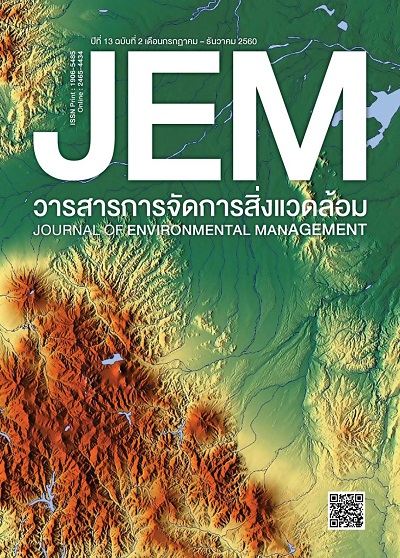บทบาทของโรงงานอุตสาหกรรมในการดำเนินงานเฝ้าระวังสิ่งแวดล้อม: กรณีศึกษาโรงงานในนิคมอุตสาหกรรมภาคเหนือ จังหวัดลำพูน ROLES OF INDUSTRIES IN ENVIRONMENTAL SURVEILLANCE IMPLEMENTATION
บทคัดย่อ
การดำเนินงานเฝ้าระวังสิ่งแวดล้อมที่ดีโดยเฉพาะในโรงงานอุตสาหกรรมจะสามารถป้องกันผลกระทบหลายด้านทั้งสิ่งแวดล้อมและสุขภาพ การศึกษาครั้งนี้มีวัตถุประสงค์เพื่อศึกษาบทบาทของโรงงานอุตสาหกรรมในการเฝ้าระวังสิ่งแวดล้อม ทำการศึกษาเชิงคุณภาพในพื้นที่นิคมอุตสาหกรรมภาคเหนือ จังหวัดลำพูน กลุ่มผู้ให้ข้อมูลหลักประกอบด้วย เจ้าหน้าที่ฝ่ายสิ่งแวดล้อม เจ้าหน้าที่ความปลอดภัยในการทำงาน พนักงานและผู้บริหารของโรงงานอุตสาหกรรม จำนวน 37 คน เก็บข้อมูลโดยการประชุมกลุ่มย่อยโดยแบ่งการสนทนากลุ่มออกเป็น 4 กลุ่ม กลุ่มละประมาณ 8 – 9 คน และการศึกษาเฉพาะกรณี จำนวน 4 สถานประกอบการวิเคราะห์ข้อมูลโดยใช้เทคนิคการวิเคราะห์แก่นสาระในการตรวจสอบความถูกต้องของข้อมูลโดยใช้การตรวจสอบแบบสามเส้า ผลการศึกษาพบว่า บทบาทของผู้ประกอบการในด้านการจัดการสิ่งแวดล้อม ประกอบด้วย บทบาทด้านการกำหนดนโยบายสิ่งแวดล้อม บทบาทด้านการวางแผน บทบาทด้านการปฏิบัติและดำเนินการ บทบาทการตรวจสอบและแก้ไข บทบาทด้านการทบทวนแผนงานโครงการและบทบาทด้านการรับผลประโยชน์ที่ได้จากการพัฒนาระบบการจัดการสิ่งแวดล้อม ในส่วนของสถานประกอบการในนิคมอุตสาหกรรมหรือหน่วยงานอื่น ๆ ที่เกี่ยวข้องสามารถนำเอาข้อมูลที่ได้ไปวางแผน พัฒนาและเฝ้าระวังคุณภาพสิ่งแวดล้อมให้เกิดความยั่งยืนต่อไป
The implementation of environmental surveillance, especially in industry can prevent both the environmental and health effects. This study aimed to investigate the roles of industry in environmental surveillance by applying the qualitative method in a northern industrial estate in Lamphun Province. Thirty-seven of the informants were environmental officers, safety officers, and staff and managers of the industries. The data were collected using focus group discussion with four groups. The size of each group was between eight to nine people. A case study was also used in four industries. The data were analyzed by thematic analysis and validated using triangulation techniques. The results showed that the roles of entrepreneurs in environmental surveillance implementation consisted of roles in the following: 1) formulating an environmental policy; 2) planning; 3) implementing; 4) monitoring; 5) revising the plan; and 6) receiving benefits from the development of environmental management. The industries in the northern industrial estate or other enterprises can utilize the results from this study in planning and developing an environmental surveillance system for sustainable development.
เอกสารอ้างอิง
Industrial Estate Authority of Thailand (1998). Yearly Report 1998 [In Thai]. Bangkok: Industrial Estate Authority of Thailand.
Kittinattapong, N., (2012). Analysis to restore air for pollution control area in Rayong province [In Thai]. Sukhothai Thammathirat Journal of Economics, 6 (2), 01 – 18.
Lei, S., & Yi, Q. (2004). Strategy and Mechanism Study for Promotion of Circular Economy in China. Chinese Journal of Population Resources and Environment, 2 (1), 5 – 8.
Lowe, E. (2001). Eco-Industrial Park Handbook for Asian Development Countries. Final Report. Asian Development Bank.
Office of Environmental Policy and Planning and the Institute for Policy Studies. (2014). Guidelines for public participation in the environmental impact assessment [In Thai]. Bangkok: Office of Environmental Policy and Planning.
Office of Natural Resources and Environmental Policy and Planning. (1999). Documents for the meeting of the Subcommittee environmental management industry in the western coastal areas, 1/1999 [In Thai]. Unpublished document.
Park, H., Chah, S., Choi, E., Kim, H., & Yi, J. (2002). Releases and transfers from petroleum and chemical manufacturing industries in Korea. Atmospheric Environment, 36, 4851 – 4861.
Pollution Control Department. (1998). Pollution Act of 1998 [In Thai]. Bangkok: Pollution Control Department.
Ramkul, K., Sripoung, N., & Lamun, N. (2008). Risk to Population Health from Pollution [In Thai]. Bangkok: National Board of Health.
Ritsri, S. (2009). Model development of the environmental management in fresh market, Kokpra sub-district, Kantharawichai district, Mahasarak ham province [In Thai]. Independent Study, Master’s degree in Public Administration, Department of Local Government, College of Local Administration, Khonkaen University.
[US EPA] United States Environmental Protection Agency (2007). Source Classification Code. Retrieved February 2, 2017, from https://ofmpub.epa.gov/sccsear ch/
Vichi-Vadakarn, N., Vajanapoom, N., Channarong, P., Chuersuwan, N., Mongkolsumrit, S., & Watchalayann, P. (2010). Studies of health impact assessment from environmental pollution in the pollution control area, Rayong Province [In Thai]. Ministry of Public Health.



